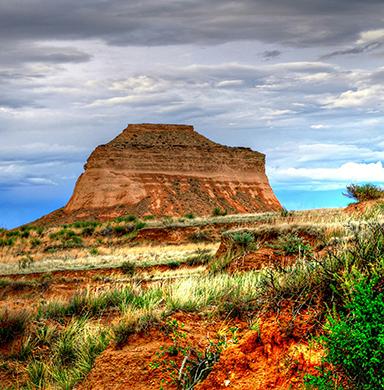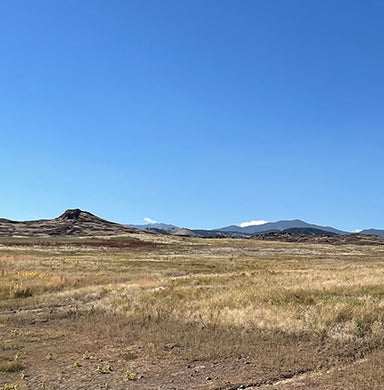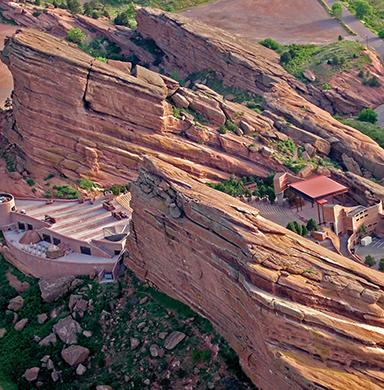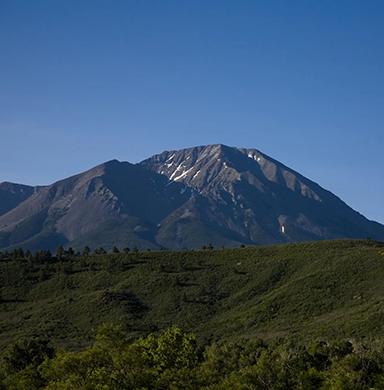A Geology Expert’s Guide to Colorado’s Coolest Rock Formations
University of Denver Associate Professor Michael Kerwin shares a few of his favorite lesser-known locations to take students for on-site lessons.

Colorado National Monument
What better way to delve into Colorado’s history than by exploring some of its many different rock formations? Whether by foot, car, bike, or rock climbing, the state is filled with Mother Nature’s art.
From north to south, Michael Kerwin, director of the Environmental Science Program and an associate professor in the Department of Geography & the Environment at the University of Denver, shares a few of Colorado’s less commonly traveled geologic marvels—along with a few bonus recommendations from the DU Newsroom.
Pawnee Buttes
2 hours 13 minutes from DU
The first geological destination is in the northeast corner of the state, roughly 13 miles south of the Wyoming border.
What are otherwise grassy plains surrounding the area, the Pawnee Buttes—formed by sedimentary rock that rise approximately 300 feet from the ground—make for a striking environmental juxtaposition.
A two-mile trail leads hikers to the first butte, while the second butte is on private land. Climbing on the rocks is not allowed, nor is mountain biking.
Located immediately beneath the rocks is the Ogallala Aquifer, North America’s largest aquifer.
“It’s beautiful out there, it’s subtle, but the sandstone rocks that they’re looking at are the ones that—when they’re underground—hold the groundwater. It’s this incredible resource, really allowing for a lot of the agriculture that takes place in the Great Plains,” Kerwin says.
North Table Mountain
30 minutes from DU
The next spot is the only place in the Denver metro area where you can find volcanic rock: Golden’s North Table Mountain.
“The entire North Table Mountain is made up of three lava flows,” he says. “It makes for really great rock climbing because it's hard and you have the cracks.”
In fact, both North Table Mountain and its sister mesa, South Table Mountain, were formed from lava flows about 60 million years ago.
When looking at the rocks themselves, visitors can see what’s called columnar jointing—a six-sided column-type pattern in volcanic rock that was formed from the magma when it cooled.
North Table Mountain is home to more than 15 miles of hiking trails, complete with panoramic views of the Front Range.
Red Rocks
25 minutes from DU
The geologic magnificence of Red Rocks Park & Amphitheatre is no secret; however, Kerwin takes students to this spot for a specific reason you may not know about.
Near the entrance to the top of the amphitheater is a plaque tells the story of a contact (where two rocks of different ages touch one another) between the 1.7-billion-year-old Pre-Cambrian basement rock and the newer Fountain Formation from 300 million years ago.
The rocks were formed when the Rocky Mountains were eroded and the rocks weathered, giving them their reddish color.
“When you get two different-aged rocks on top of each other, there’s a whole lot of missing Earth history in between,” he says, adding that it’s also referred to in geology as an unconformity. “Many visitors probably don’t get a chance to ponder how amazing that is.”
Spanish Peaks
3.5 hours from DU
The Spanish Peaks are in the southern part of the state and are a prime example of what geologists call “stocks."
Stocks are large groups of igneous or molten rocks layered by sedimentary rock and later exposed by erosion.
The peaks are also home to a prominent feature called a dike, which radiates out from the mountains and looks like the spokes on a bicycle.
“It can be this incredible aha moment … I take students to the top of West Spanish Peak, and from the top you can look down and see these features in the landscape that extend out for miles—it’s really neat,” Kerwin says.
Picket Wire Canyonlands
3 hours 25 minutes from DU
Staying in the southern part of the state, the Picket Wire Canyonlands are home to the largest dinosaur track site in North America.
In fact, visitors can see more than 1,900 prints in 130 separate trackways, according to the U.S. Forest Service website. The round-trip hike to the dinosaur tracks is 11.2 miles, so be sure to bring lots of water.
What makes Picket Wire unique, compared to, say, Dinosaur Ridge, is how many different species of dinosaur footprints are preserved, Kerwin says.
“People don't know about this because it’s far away, but it's really well worth it for people who are geology enthusiasts,” he adds.
A few other recommendations from the DU Newsroom:
Colorado National Monument
4 hours 40 minutes from DU
Located in Grand Junction near the border of Utah, visitors can hike, bike, camp, rock climb, picnic or drive throughout Colorado National Monument. Rim Rock Drive, an approximately 23-mile route, is a classic way to take in all the sights and enjoy the many scenic overlooks.
Rocks exposed in Colorado National Monument range in age from 1,741 million years old to approximately 100 million years, according to the National Park Service.
Black Canyon of the Gunnison
4 hours 50 minutes from DU
Sculpted by both the Gunnison River and the process of weathering, you can find Black Canyon of the Gunnison in west-central Colorado.
The “deep, steep and narrow” park, which does not require reservations to enter, is divided between the completely separate North Rim and South Rim.
Paint Mines Interactive Park
1 hours 30 minutes from DU
The Paint Mines Interpretive Park is named for the colorful clays that were collected here by Native American communities to make paint.
Located near Callahan in El Paso County, the park is free to visit and features geological formations including spires and hoodoos.















